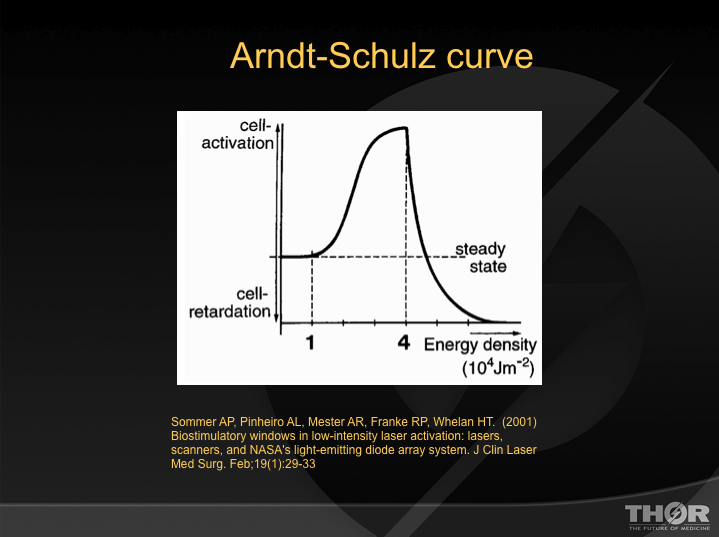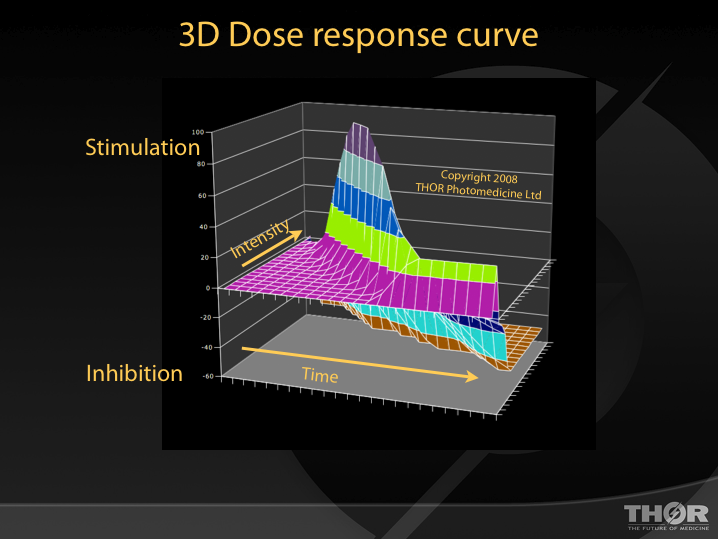Copyright 2008 THOR Photomedicine Ltd
A 3D dose model for low level laser / led therapy biostimulation and bioinhibition
James D Carroll
ABSTRACT
There have been numerous reports describing the phenomena of biostimulation and bioinhibition using low-level laser therapy (LLLT) and other light and IR sources within the laboratory and in clinical trials. Stimulation or inhibition employed correctly has been shown clinically to reduce pain, improve tissue repair, resolve inflammation and stimulate the immune system. All these effects are sensitive to different irradiance and / or different energy (sometimes described as dose rate or fluence rate effects). The typical ranges for biostimulation and bioinhibition will be examined and a 3D Arndt Schulz style model proposed to illustrate possible ‘dose sweet spots’ for the intended clinical effects.
Keywords: Photobiomodulation, LLLT, Dose rate effects, inhibition.
INTRODUCTION
The Arndt-Schultz Law is frequently quoted as a suitable model to describe dose dependant effects of LLLT 1, 2, 3, 4. The Arndt-Schultz Law states that “weak stimuli increases physiologic activity, moderate stimuli inhibit activity, and very strong stimuli abolish activity”5, 6, 7. Simply put; a small stimulus may have no biological effect, a moderate stimulus may have a biostimulatory effect, a large stimulus may have an bioinhibitory or even cytotoxic effect. In the context of LLLT the increasing “stimulus” may be irradiation time or it may be increased beam intensity (irradiance). A biphasic response has been demonstrated many times in LLLT research 8,9,10 This non-linear effect contradicts the Bunsen-Roscoe rule of reciprocity which predicts that if the products of time of exposure time and irradiance are equal, then the quantities of material undergoing change will be equal. This inverse linear relationship between intensity and time has frequently failed in LLLT research.4,11.
THE 3D MODEL
At the NAALT 2007 conference, Anders12 hypothesised; “If we had extended the time and irradiance ranges I believe we would have found an island in the middle of the data table indicating the effective combinations”. Karu11 plotted the rate of DNA synthesis dependence on light intensity and time. Taking this template for both increases in time and intensity it has been possible to speculate and redraw this in a 3 dimensional graph to illustrate how a dose “sweet spot” for biostimulation may appear when the appropriate combinations of time and irradiance are achieved at the target tissue.
Whilst this model could help explain and explore dose rate effects it must be remembered that there are many other factors affecting LLLT dosimetry including wavelength, depth of target tissue, attenuation, target cell type, state of target cells, pulse regimes and treatment intervals. Other confounding factors include a lack of beam measurement standardisation in this field of study and some unstable laser and LED product performance. These factors mean that much published data is not robust and should be referred to cautiously. When conducting LLLT research all parameters should be recorded and published including wavelength, average power, (pulse width, pulse and peak power if any) and beam area (including the beam measurement method). The recommended method for expressing beam area is the 1/e2 point.13
Chow RT, David MA, Armati PJ. (2007) 830 nm laser irradiation induces varicosity formation, reduces mitochondrial membrane potential and blocks fast axonal flow in small and medium diameter rat dorsal root ganglion neurons: implications for the analgesic effects of 830 nm laser. J Peripher Nerv Syst. Mar;12(1):28-39.
Sommer AP, Pinheiro AL, Mester AR, Franke RP, Whelan HT. (2001) Biostimulatory windows in low-intensity laser activation: lasers, scanners, and NASA’s light-emitting diode array system. J Clin Laser Med Surg. Feb;19(1):29-33
Hawkins D, Abrahamse H. (2006) Effect of multiple exposures of low-level laser therapy on the cellular responses of wounded human skin fibroblasts. Photomed Laser Surg. Dec;24(6):705-14.
Lubart R, Lavi R, Friedmann H, Rochkind S. (2006 ) Photochemistry and photobiology of light absorption by living cells. Photomed Laser Surg. Apr;24(2):179-85
Dorland’s Illustrated Medical Dictionary
Schulz, H. (1888) “Uber Hefegiste”, Pflügers Archiv Gesammte Physiologie, Vol. 42 pp.517
Zur Lehre von der Arzneiwirkung. (1887) [Virchows] Archiv für pathologische Anatomie und Physiologie und für klinische Medizin, Berlin,; 108: 423-445.
Oron U, Yaakobi T, Oron A, Hayam G, Gepstein L, Rubin O, Wolf T, Ben Haim S. (2001) Attenuation of infarct size in rats and dogs after myocardial infarction by low-energy laser irradiation. Lasers Surg Med.;28(3):204-11.
Lanzafame RJ, Stadler I, Kurtz AF, Connelly R, A T Peter Sr, Brondon P, Olson D. 2007 Reciprocity of exposure time and irradiance on energy density during photoradiation on wound healing in a murine pressure ulcer model. Lasers Surg Med. Jul;39(6):534-542.
A. Michtchenko; M. Hernandez (2006) Photobiostimulation Effects Caused for Low Level Laser Radiation with 650 nm in the Growth Stimulus of Biological Systems. Electrical and Electronics Engineering, 2006 3rd International Conference on Volume , Issue , Sept. Page(s):1 – 4
Karu TI, Kolyakov SF. (2005) Exact action spectra for cellular responses relevant to phototherapy. Photomed Laser Surg. Aug;23(4):355-61.
Juanita Anders, Tara Romanczyk, Helina Moges, Ilko Ilev, Ronald Waynant, Leonardo Longo (2007) Light Interaction With Human Central Nervous System Progenitor Cells, NAALT conference proceedings.
James Carroll (2006) The characteristics of a LLLT / Photobiomodulation light source defines the medicine. The exposure time defines the dose. A collapsed distinction. SPIE BiOS proceedings 2006.
 Featured Testimonials
Featured Testimonials

My question is on the treatment booklets (physio-Thor, and pain-Thor) we received with our Thor lasers now obsolete or are there any updates we should be aware of? I understand you are going to recommend attending a training, but for our immediate clients any tips would be appreciated. I would like to note the LLLT is incorporated in most all of our services, except botox for obvious reasons.
Thank you,
Kim
you are right, I am going to say training https://www.thorlaser.com/training
It takes a full packed day to explain the tip that ends up with :
1) use our 810nm 5 x 200mW laser cluster over nerves for 30 seconds on continuous for analgesia
2) use our 810nm single 200mW laser over trigger points for 30 seconds on continuous to deactivate trigger points
3) use LED Cluster at 2.5Hz for superficial injuries (<1cm deep) 1 min to promote healing
4) use laser at 2.5Hz over deep injuries (>1cm deep) 1 min to promote healing
5) use LED Cluster at 2.5Hz over lymph nodes (<1cm deep) 1 min to reduce edema